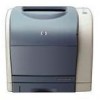HP 2500 HP PCL/PJL reference - Printer Job Language Technical Reference Manual - Page 58
PJL Job Security, Password Protection of Default Feature Settings, Settings
 |
View all HP 2500 manuals
Add to My Manuals
Save this manual to your list of manuals |
Page 58 highlights
PJL Job Security HP LaserJet 2100 series, 4000 series, 4500 series, 5000 series, 8000 series, 8100 series, 8500 series, 4/4M Plus, 4V, 4MV, 4Si, 4SiMx, 5, 5M, 5Si, 5SiMx, 5Si Mopier, 5P, 6P, and 6MP printers support the following types of PJL security: • Password protection of default feature settings-this type of security prevents applications from modifying the printer's default feature settings unless the correct password is specified. • Control panel lock-prevents users from modifying control panel settings using the control panel keys. • Disk lock (LaserJet 4V, 4MV, 4000 series, 5000 series, 8000 series, 8100 series, 8500 series, 5, 5M, 5Si, 5SiMx, 5Si Mopier only)-prevents writing to the printer's disk (or flash memory). • File system initialization-for printers with a PJL file system, the FSINIT command will not initialize the file system unless specified in a secure job. All types of security are set using the DEFAULT command and queried using DINQUIRE or INQUIRE. Password Protection of Default Feature Settings You can use a password to protect the printer's default features by sending the @PJL DEFAULT PASSWORD = number command, specifying a number between 1 and 65,535 (the 0 value disables password protection). Once password protection is enabled, the DEFAULT or INITIALIZE commands are disabled unless the correct password is specified in the JOB command. Printer languages, such as PCL and PostScript, are also prevented from changing default variables. Secure PJL jobs are able to use the DEFAULT and INITIALIZE commands (or printer language commands) to set default features, including the value of the PASSWORD, CPLOCK, and DISKLOCK variables, until the next EOJ command is received. 5-10 Job Separation Commands EN















